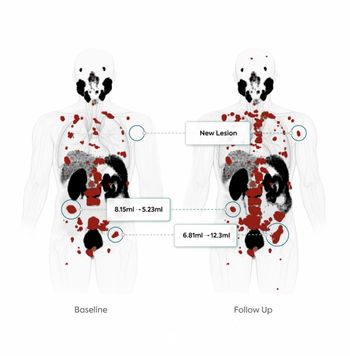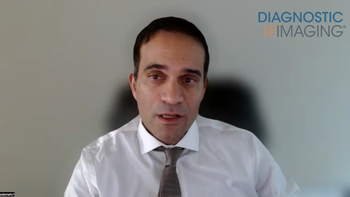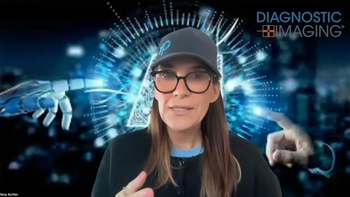
Contrast-enhanced ultrasound achieves new breakthroughs
Despite the FDA's reluctance to approve the use of contrast agents for diagnostic ultrasound other than for cardiac applications, clinical research in this area continues around the world. Researchers are particularly interested in validating the effectiveness of contrast-enhanced ultrasound imaging for the noninvasive diagnosis of cancer.
Despite the FDA's reluctance to approve the use of contrast agents for diagnostic ultrasound other than for cardiac applications, clinical research in this area continues around the world. Researchers are particularly interested in validating the effectiveness of contrast-enhanced ultrasound imaging for the noninvasive diagnosis of cancer.
Evaluations under way at Thomas Jefferson University are focusing on the use of gas-encapsulated microbubble contrast agents with nonlinear ultrasound imaging techniques to not only detect but also help characterize breast cancer noninvasively. Other recent studies have examined how microbubble contrast agents interact with ultrasound acoustic fields to demonstrate the effectiveness of contrast-specific imaging in visualizing microvascular details. This information is useful for the early detection of cancer-related malignancies and lesions and for monitoring tumor angiogenesis.
Additionally, research is ongoing to further expand the use of microbubble contrast agents in ultrasound imaging for advanced cardiac applications such as noninvasive pressure estimation for assessing heart and vascular diseases.
Diagnostic ultrasound is the most frequently used imaging modality in the world, accounting for approximately 25% of all imaging studies. It offers many potential advantages for noninvasive cancer detection. Ultrasound provides physicians with real-time imaging of tissue structures and their movements. It enables functional imaging of flow in larger blood vessels and organs with higher temporal resolution than MR or CT. Diagnostic ultrasound is generally safe, without harmful ionizing radiation that can potentially raise the risk of cancer, and it has a larger installed equipment base than any other modality.
For more than 35 years, researchers have recognized the effectiveness and increased diagnostic capabilities of ultrasound imaging with the use of contrast agents, which improve sensitivity and specificity. With the development of microbubble contrast agents, ultrasound has achieved noteworthy diagnostic breakthroughs and enabled new clinical applications for contrast-enhanced imaging.
Ultrasound contrast agents are gas-encapsulated microbubbles less than 8 micron in diameter (about the same size as red blood cells). They are injected intravenously to circulate in the blood stream and improve image quality by increasing the backscattered ultrasound signals from the vasculature of tissue structures.1 Because microbubble contrast agents behave nonlinearly and are acoustically different from surrounding fluids and tissue, the ultrasound signal-to-noise ratio is dramatically increased, resulting in better visualization of blood vessels and organs throughout the body.
The nonlinear properties of microbubble contrast agents have been used to create contrast-specific imaging modalities such as harmonic and subharmonic ultrasound imaging. Another novel contrast imaging technique is Micro Flow Imaging (Toshiba America Medical Systems), which combines specific nonlinear properties of the microbubbles with the movement of individual bubbles through tumor neovessels.
Micro Flow Imaging allows tracing of individual microbubble contrast agents over time to deliver
contrast harmonic images at high resolution with detailed definition. It uses subtraction and summation techniques to outline tortuous vessels that have only minute traces of contrast, producing images captured with maximum intensity. Summed images constructed over time outline even capillary vessels. Examinations using this technique have proved especially useful in assessing the slowly perfused mammary organ, small organ parts, and the microvasculature of abdominal organs.
BREAST CANCER
Micro Flow Imaging and Vascular Recognition Imaging may also help improve detection of breast cancer. Because about 80% of biopsies performed for breast cancer are classified as benign, a substantial number of women undergo unnecessary procedures. Using microbubble contrast agents, ultrasound can noninvasively provide additional diagnostic information about breast tumors before biopsies are performed. Contrast-enhanced ultrasound evaluations not only provide an idea of the blood flow in the larger feeding vessels but also image background perfusion in the microvasculature that typically cannot be visualized with ultrasound imaging.
Physicians' ability to see or obtain signals from blood vessels is improved by an order of magnitude with contrast-enhanced ultrasound. In standard ultrasound, blood can be seen in real-time pulsating through vessels that are approximately 200 to 300 micron (0.2 to 0.3 mm) in size. Administering a microbubble contrast agent, however, makes it is possible to obtain signals from vessels in the range of 30 to 40 micron, the lower end of angiogenic tumor vessels. Procedures in breast lesions have already demonstrated this order of magnitude improvement in vascular imaging, accompanied by a dramatic increase in the ultrasound signal-to-noise ratio. Signals are increased by approximately 20 to 30 dB, improving visualization of vascular structures and blood flow throughout the body.
Other recent studies of the use of contrast-enhanced ultrasound imaging for breast cancer diagnosis have provided statistically significant improvements over ultrasound sonography and mammography. Fifty-five patients who underwent breast biopsies participated in a study that compared mammography and contrast-enhanced sonography using microbubble contrast media.
The researchers obtained power Doppler data from the lesions. Their findings demonstrated that the area under the receiver operating characteristic curve for the diagnosis of breast cancer increased from 0.51 for conventional 2D contrast-enhanced imaging and 0.60 for 3D power Doppler imaging to 0.76 with 3D contrast-enhanced imaging. Mammography produced an area of 0.86, which increased when combined with 3D contrast-enhanced imaging to 0.90 and with all sonographic modalities to 0.96.2 Three-D contrast-enhanced imaging clearly increased the ability to diagnose breast cancer relative to conventional ultrasound imaging and mammography alone in this relatively small patient population.
These new techniques and the use of contrast agents provide noninvasive characterization of breast cancer and could potentially save an enormous amount of time and anxiety for patients. These are, after all, the primary reasons for developing new imaging methods.
TUMOR ANGIOGENESIS
New research in tumor angiogenesis has also demonstrated contrast-enhanced ultrasound's effectiveness for early detection of cancer by looking at the development and growth of small neovessels associated with malignant tumors.
For a cancer to grow more than 2 to 3 mm in diameter, cells must begin to secrete various chemicals called angiogenic growth factors. This activity forces the anterior cells to form a chaotic network of soft, pliable neovessels that become the blood supply for the tumor. The tumor can grow by taking more nutrients in and letting more waste products out. The larger the tumor becomes, the more growth factors it secretes, and the more neovessels it builds. As these factors can be used as an independent marker of malignancy and of prognosis, ultrasound techniques using microbubble contrast agents can noninvasively determine, albeit indirectly, the expression of angiogenic growth factors and thus assist in determining the most appropriate treatment for cancer patients.
Other studies of the fundamentals of tumor angiogenesis and the implications for contrast-enhanced ultrasound imaging have been conducted. Additional imaging options are required to enhance the visualization of the neovasculature associated with cancer.
In one study, 28 athymic nude mice were implanted with human melanoma cells and imaged using ultrasound contrast agents, power Doppler, and pulse inversion harmonic techniques.3 Quantitative results demonstrated that contrast-enhanced ultrasound has great potential to supply clinically relevant information related to angiogenesis. Measuring tumor flow and vascular volume at different stages in the progression of the tumor may provide important information on the response of tumors to antiangiogenic therapies. Contrast-enhanced ultrasound imaging of tumor neovascularity may produce noninvasive markers of angiogenesis and could become a useful diagnostic tool for assessing anti-angiogenic cancer therapies.
These studies demonstrate that contrast-enhanced diagnostic ultrasound can effectively diagnose and characterize cancers, present noninvasive options to patients, and possibly allow certain surgical interventions to be ruled out.
PRESSURE ESTIMATIONS
Noninvasive pressure estimation in heart cavities and major vessels would provide clinicians with a valuable tool for assessing patients with heart and vascular diseases. Some microbubble-based ultrasound contrast agents are particularly well suited for pressure measurements because the substantial compressibility of microbubbles enables them to vary significantly in size in response to changes in pressure. Pressure changes should then affect reflectivity of microbubbles after intravenous injection of a contrast agent. This has been demonstrated with a galactose-based contrast agent (Levovist, Schering) using 2-MHz ultrasound tone bursts. Preliminary results indicate that, over the pressure range of 0 to 186 mm Hg, the subharmonic amplitude of scattered signals decreases by as much as 10 dB under optimal acoustic settings, and the first and second harmonic amplitudes decrease by less than 3 dB. An excellent correlation between the subharmonic amplitude and the hydrostatic pressure suggests that the subharmonic signal may be used for noninvasive detection of pressure changes.4
A noninvasive technique to measure pressure changes could offer physicians clinically useful information such as measuring vascular obstruction, as well as the ability to follow up patients with hypertension, which might indicate the need for early therapeutic interventions.
QUESTION FOR FDA
Clinical research has attracted enthusiasm for contrast-enhanced diagnostic ultrasound imaging and its potential usefulness as a noninvasive diagnostic and patient management tool. It can provide vital information that helps determine the best course of treatment. Whether these important diagnostic imaging procedures will become available to benefit patients in the U.S. is an ongoing question for the FDA. Researchers, contrast agent developers, and manufacturers of commercial ultrasound equipment are pushing to advance the technology behind the modality to bring about changes that will ultimately save lives.
Dr. Forsberg is director of ultrasound physics and a professor of radiology at Thomas Jefferson University in Philadelphia. He has been a consultant to and has received research support from Toshiba America Medical Systems.
References
1. Goldberg BB, Raichlen JS, Forsberg F. Ultrasound contrast agents: basic principles and clinical applications, 2nd ed. London, England: Martin Dunitz Ltd., 2001.
2. Forsberg F, Goldberg BB, Merritt CR, et al. Diagnosing breast lesions with contrast-enhanced 3-dimensional power Doppler imaging. J Ultrasound Med 2004;23:173-182.
3. Forsberg F, Ro RJ, Potoczek M, et al. Assessment of angiogenesis: implications for ultrasound imaging. Ultrasonics 2004;42:325-330.
4. Shi WT, Forsberg F, Raichlen JS, et al. Pressure dependence of subharmonic signals from contrast microbubbles. Ultrasound Med Biol 1999;25:275-283.
Newsletter
Stay at the forefront of radiology with the Diagnostic Imaging newsletter, delivering the latest news, clinical insights, and imaging advancements for today’s radiologists.



























